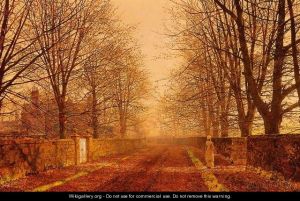Where do creative people get their inspiration? There are probably as many answers to that question as there are creators, and in all likelihood, every creator uses more than one source. However, such non-specific statements explain nothing. An example or two, while indicating only a miniscule portion of the possibilities will be far more illuminating.

Trivial incidents in an artist’s life can inspire complex works. Art can sometimes inspire art.
This may not always be obvious, but all inspiration is actually a two-part process. There is an outer stimulus, and there is an inner response. The inward component goes beyond the pure emotional response to the experience. What the creative individual feels, stimulates some deeply held emotion-laden idea or value. There is energizing resonance.
The Humble Origins of Inspiration
It is amazing how trivial a source of inspiration can be. The sight of an old fat woman gazing over the gate of a housing estate at the fields of the English Midlands inspired Angus Wilson’s complex novel, Late Call. From the mundane image, he concocted an entire family in the process of coming apart as they lived in one of Britain’s carefully planned yet sterile “progressive” communities. By standing at the gate, the boundary between the town and the country, the old woman had stirred Wilson’s own mixed feelings about town life versus country life. In his work, he often contrasted the image of the wild garden with that of the cultivated garden. In life, he had a flat in London and a rustic cottage in Suffolk dividing his time between them. The old woman had inadvertently played into Wilson’s inner debate sparking a creative outburst where he could make use of his own experience.
Angus Wilson made lists of possible “ideas” or “psychic moments” which he wove together when writing a novel. A list he compiled while working on No Laughing Matter has 30 entries, one item being very autobiographical: “mother and me on the road from Porlock.” These psychic moments are very like Virginia Woolf’s “moments of being.” One wonders if Woolf’s example inspired Wilson to use such often-trivial experiences as a basis for his work.
Wilson was a copious maker of notes – although his final product did not always seem drawn entirely from them. Notes are part of the rather murky process of gestation that comes after the initial inspiration. They are where the bits and pieces, some garnered from without, some from within, are gathered together as the project evolves.
Art Can Inspire More Art
Another source of inspiration for art can be art itself. Many a symphonic or piano work has been inspired when composers visited a picture gallery or exhibition. Perhaps the most famous of these is Mussorgsky’s Pictures at an Exhibition. The Russian composer based each of the suite’s ten movements on his subjective response to a particular painting. He used his own art form to capture in sound the emotional tone of works created by visual artists. In a sense, he translated the visual response of the original artist into his own aural response.
A Personal Example
Let me end with a personal example of how a particular inspiration might work. The Wilson anecdote I led off with combines with the mention of art to remind me powerfully of Atkinson Grimshaw’s painting, “Golden Light.” I first encountered this moody work as a tiny reproduction decorating my Naxos recording of Walton’s Symphony No. 1 and was enthralled. In the painting, a bell-hatted woman in an ankle-length dress and a long overcoat gazes through a gap in a head-high, mossy stone wall, apparently at the setting sun. The scene is a remarkable evocation of misty tranquility. I can smell coal smoke and decaying leaves in the cool autumn air. What the woman sees is not visible, a fact that prompts a good deal of imaginative speculation! Moreover, I wonder who the woman is. What is she doing in this leaf-strewn street? Note the barely visible tire marks in the road. Is the woman waiting for a bus? What is the quiet street like when one comes rumbling around the bend? What goes on behind those tall cold walls?
I was born in England, and although I left there more than half a century ago when still just a boy, I have many memories of what it was like. When I look at Grimshaw’s evocative painting, I recall streets with walls even taller than those he has depicted (or so they seemed at the time). The houses behind were visible over the tops, just the same. Incidents come back to me, feelings, sad memories of relatives we left behind, in some cases never to see again. It is easy to grasp how a simple scene or a painting can get the creative juices flowing.
One thought on “Where Creative People Get Their Ideas”